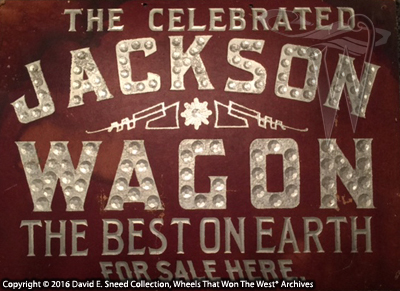For me, chasing America’s western,
wheeled history never gets old. The
subject is too deep with too many unanswered questions and even more
‘treasures’ still to be uncovered. Every
day is an opportunity to rescue a lost part of our past.
As I’ve shared before, there are a
number of legendary wagon brands that, for all practical purposes, have just
disappeared. I’m talkin’ gone… history…
vanished… vamoosed. Making things even
more incredible is the fact that none of these companies were fly-by-night
short-timers. These were brands that
existed for decades. Some built vehicles
for as much as three-quarters of a century!
In a way, it’s a little like the lost colony of Roanoke in North
Carolina. It’s somewhat of a mystery as
to why no actual vehicles from these brands have ever come to light.
Undaunted, I (and others I know) still
look daily for any signs of early 19th century wagon brands... major names like
Espenschied, Murphy, Jackson, Kansas, Caldwell, Whitewater, Star, LaBelle, and
Coquillard deserve more of a visual legacy than a few rough illustrations from
the time. Why? Because each of these brands (and others)
were the real pioneers in America’s first transportation industry. Similarly, each shares an amazing history of
quality and was repeatedly listed by early voices as being among the very Best in the West.
Fortunately, vigilance has a way of
paying off. Over the years, we’ve been
able to uncover a host of materials, as well as a few of these period vehicles,
just by paying attention to details and connecting the dots. As an example, not long ago, I came across an
old photo of a business in Topeka, Kansas.
From the people and vehicles in the frozen frame to the buildings and
signage, there was a lot going on in the image.
As I studied the original sepia-toned details, I noticed a large
promotional sign for Jackson Wagons in the background. Looking closer, one of the wagons had the
name ‘Jackson Common Sense’ painted on it.
It was a revelation for me in that I’d never heard of Jackson wagons
referred to in that way. Was this the
same company out of Jackson, Michigan?
After doing a little detective work, it turns out that, “Yep,” it
was. A little more research helped me
narrow down the date of the photo to a timeframe between 1876 and 1881.
Why is this important to anyone other
than myself? There are several reasons
that any western buff, wagon collector, or vehicle historian should take
note. First, during America’s mass
migrations west, Jackson is one of the more legendary brands and is often
listed among the favorites – even among freighters. Second, as broad as the world-wide-web is,
try to find an actual photo of an early Jackson wagon. Go ahead.
I’ll wait…
 |
This store window sign promoting Jackson Wagons is a rare survivor. It’s colored with reflective dots for added visibility at night. |
Okay.
You back? Pretty slim pickens,
huh? Yes, you likely ran across some
literature from the late 1800’s but did any of it carry the 1870’s and earlier
look of the brand? Even rarer will be
the discovery of almost any photos of this brand. The same phenomenon exists with wagons built
by Joseph Murphy, Louis Espenschied, Alexander Caldwell, Augustine Cooper, and many
more –
in fact, finding any photo showing a wagon still emblazoned with its
clearly-labeled brand taken at or before the year 1880 is a tall order.
So, back to why this is important… I think I was at the third point – How can
we, as stewards of America’s western history, not know more about the vehicles
that made the trek west possible? By the
same token, how can any story of the West be fully told (at least correctly)
without including these amazing wheels of commerce and competition? Fourth – How many of these legendary western
wheels are still out there and, fifth, how can we recognize them without
primary source documentation like these photos?
Ultimately, that’s what keeps me focused
and intrigued by this subject. It’s
impossible to always know what’s around the next corner – but, when those lost
gems of history do show up, it can be pretty exciting as each one provides even
more understanding of not just how the west was won but who did it. So, keep your eyes peeled and if you should
happen to run across a heavily weathered, beaten down Jackson, don’t be afraid
to gather it up and take it home. No
matter the condition, any of these relics confirmed to be from the 1870’s and
‘80’s are extremely rare parts from an internationally renowned past. As the folks building wagons in Jackson,
Michigan might have said, “It’s just good Common Sense!”
By the way, if you haven’t signed up to receive this weekly blog via e-mail, just type your address in the "Follow By E-mail" section above. You'll receive a confirmation e-mail that you'll need to verify before you're officially on board. Once that's done, you'll receive an email every time we update the blog. Please don't hesitate to let us know if we can be of assistance. We appreciate your continued feedback and look forward to sharing even more throughout the year.
Have a good week!
Please Note: As with each of our blog writings, all imagery and text is copyrighted with All Rights Reserved. The material may not be broadcast, published, rewritten, or redistributed without prior written permission from David E. Sneed, Wheels That Won The West® Archives.
